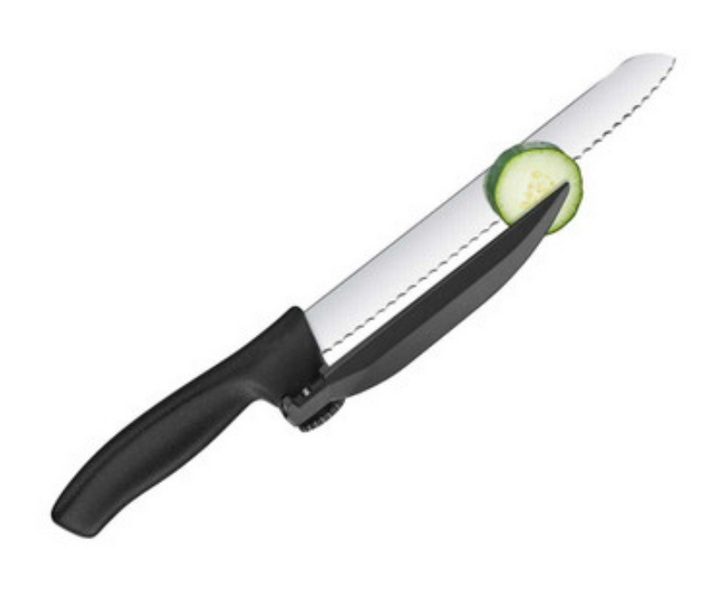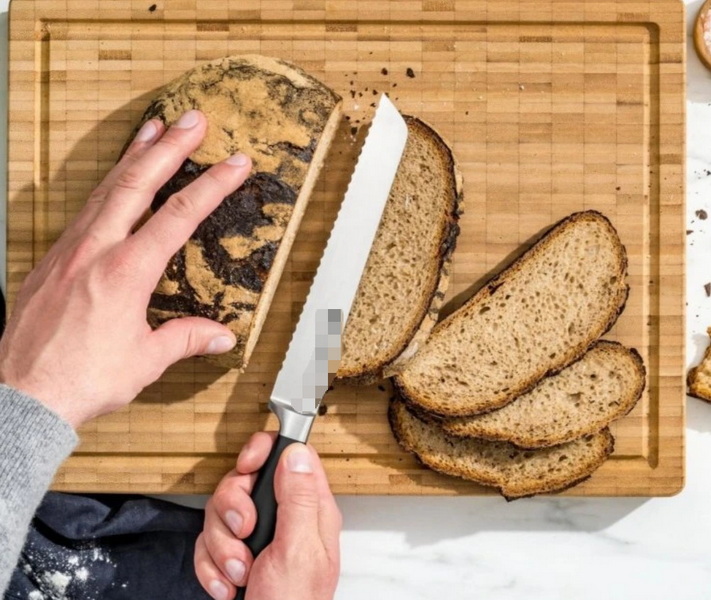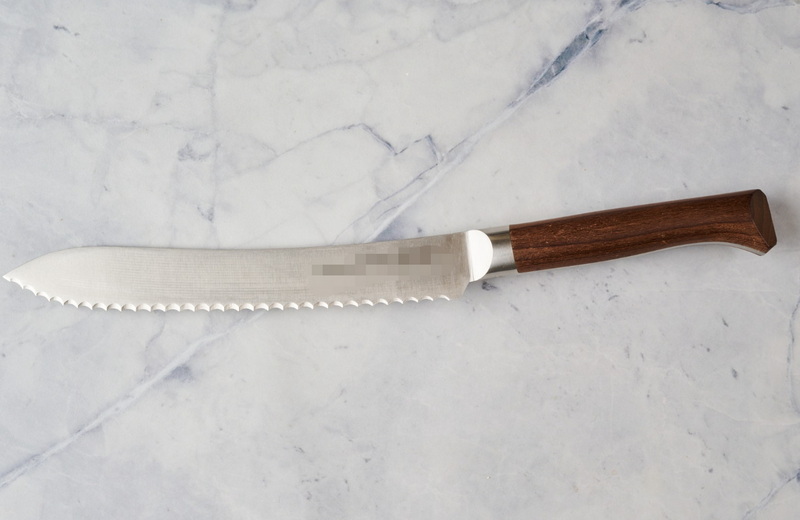- All
- Product Name
- Product Keyword
- Product Model
- Product Summary
- Product Description
- Multi Field Search
Views: 222 Author: Ann Publish Time: 2025-11-05 Origin: Site











Content Menu
● Blade materials and performance
● Handle design and ergonomics
● Construction, quality control, and reliability
● Maintenance, care, and longevity
● Media-rich marketing and education
● Materials, sustainability, and supplier considerations
● Customization and OEM considerations
● Applications and market contexts
● Practical examples of bread knife configurations
● Frequently Asked Questions (FAQ)
>> What is the best blade material for a bread knife?
>> Should a bread knife be forged or stamped?
>> How long should a bread knife blade be?
>> What are the advantages of serrated edges for bread knives?
>> How should a bread knife be cared for?
Bread knives are indispensable in any professional kitchen and in serious home kitchens alike. Their serrated blades are purpose-built to glide through crusty crusts while preserving the soft crumb inside, a balance that distinguishes them from non-serrated chef's knives. For brands engaging in OEM partnerships, understanding the interplay between blade material, serration design, blade length, handle ergonomics, and assembly quality is essential to deliver bread knives that perform reliably across diverse markets and volumes. This guide delves into the core components of a bread knife, discusses material choices, examines serration patterns, compares construction methods, and outlines practical considerations for marketing, customization, and maintenance.

The blade is the heart of any bread knife. The choice of steel determines edge retention, corrosion resistance, ease of maintenance, and overall durability in busy kitchen environments. Common options include high-carbon stainless steels, which combine hardness and rust resistance, and premium stainless steels with enhanced wear properties. Some OEM programs may explore alloying elements such as chromium, vanadium, and molybdenum to improve edge stability and corrosion resistance for extended service in humid, maritime, or industrial settings. The manufacturing process—heat treatment, quenching, and tempering—significantly influences the blade's hardness, toughness, and ability to hold a sharp edge through repeated use. Consistent blade geometry and precise centering are crucial for predictable slicing performance.
- Serration patterns and edge geometry
Serration is what enables bread knives to saw through crusts without tearing the crumb. Different tooth designs—ranging from traditional large-tooth serrations to finer, scalloped patterns—affect bite, cutting speed, and crumb integrity. A broader tooth profile tends to grip crustier loaves more effectively but may require more frequent sharpening; finer serrations offer smoother cuts on softer breads but can wear differently with high-volume use. For OEM programs, offering a selectable serration family (e.g., standard serrated, micro-serrated, and sine-wave patterns) can align with varied bread textures and customer preferences.
- Blade length, weight, and balance
Standard bread knife lengths span from roughly 8 to 12 inches (200–300 mm). Shorter blades offer nimble handling and precise control for delicate breads, while longer blades enable efficient single-pass slicing of large loaves. The knife's weight and balance influence fatigue and control during extended service. A well-balanced design distributes weight along the blade's center of mass, reducing wrist strain. OEM strategies can tailor blade length and overall weight to target segments such as home cooks, mid-volume bakeries, and high-end restaurants.
- Blade construction and finish
Forged blades typically deliver superior balance and edge stability, while stamped blades may provide cost advantages and lighter weight. Finishes—polished mirror, satin, or matte—affect corrosion resistance, food release, and ease of cleaning. Operators should consider finish compatibility with sanitization protocols and dishwasher exposure in each target market. Clear documentation of heat treatment, material provenance, and production tolerances supports transparency with brand customers.
- Edge geometry and maintenance implications
Beyond material, the geometry of the edge influences how aggressively the knife cuts and how long the edge remains sharp. A bread knife that is easier to sharpen in a high-volume setting reduces downtime and maintenance costs for professional kitchens. OEM partners may offer guidance on recommended sharpening intervals, compatible sharpening systems, and customer-facing maintenance videos to extend product life.
The handle is where control, comfort, and safety converge. Ergonomic bread knife handles minimize fatigue during repetitive slicing tasks and improve accuracy, particularly in institutions with demanding throughput. Key ergonomic considerations include:
- Grip texture and material: non-slip surfaces (e.g., synthetic composites, stabilized wood) improve control in wet conditions.
- Contoured shape: profiles that fit a wide range of hand sizes reduce strain and enhance maneuverability.
- Hardware and construction: full tang with robust rivets or a solid, one-piece handle increases durability under heavy use.
- Knuckle clearance: adequate space between handle and blade prevents interference during cutting motions and reduces the risk of knuckle contact with the blade.
- Hygienic design: smooth surfaces with tight seams that are easy to sanitize, with materials resistant to disinfectants used in commercial kitchens.
OEM programs can tailor handle material (wood, polymer composites, or hybrid options), colorways, and branding elements to align with customer identity while meeting hygiene and maintenance standards.
Reliable bread knives require consistent manufacturing practices, stringent quality control, and clear specifications. The following aspects matter for market-ready products:
- Tang and scale design: full tang constructions provide superior balance, while three-rivet handles are common in mid-range offerings.
- Blade-to-handle fit: tight tolerances prevent looseness and ensure consistent performance across production lots.
- Surface treatments and coatings: coatings can reduce abrasion on cutting surfaces and help with corrosion resistance, but must be food-safe and durable under repeated wash cycles.
- Dishwasher compatibility: some handle materials tolerate dishwashers better than others; communicate clearly about care to maintain finish and longevity.
- Packaging and branding: robust packaging that protects the blade and communicates key specs (blade length, material, serration type) supports OEM sales across international markets.

Bread knife life is extended through proper usage and maintenance. Provide customers with clear care instructions as part of OEM packaging and manuals:
- Cleaning: hand wash with mild detergent and dry promptly to prevent water ingress, especially with wooden or composite handles.
- Sharpening: regular honing to maintain the micro-bevel and periodic professional sharpening to restore a keen edge. Recommend compatible sharpeners or professional service networks in target markets.
- Safe storage: use a knife block, magnetic strip, or sheath to protect the edge and prevent accidental injury.
- Usage considerations: avoid harsh impacts or prying with the blade, which can nick the edge or damage the serrations.
High-quality bread knives maintain performance across thousands of slices and dozens of loaves, making the investment worthwhile for end users and for brands seeking durable OEM partnerships.
To maximize consumer understanding and engagement, incorporate visual and video assets that showcase practical bread-cutting scenarios:
- Product photography: high-resolution shots of blade geometry, serration pattern, edge finish, and handle details from multiple angles.
- Process videos: short clips illustrating blade forging or stamping, heat treatment, and final sharpening to build trust in manufacturing quality.
- Comparison visuals: side-by-side images of different blade styles and handle configurations to aid decision-making in OEM briefs.
- How-to videos: demonstrations of correct bread-slicing technique, maintenance routines, and cleaning methods, with captions and translations as needed.
- Infographics: concise explanations of material choices, heat treatment, and care steps to accompany product pages and catalogs.
Material selection affects performance, lifecycle costs, and sustainability. Each choice should be documented with supplier and process transparency:
- Material provenance: traceability from billet to finished blade helps reassure international buyers about quality and ethics.
- Environmental impact: consider the carbon footprint of mining, alloying, finishing, and packaging; optimize processes to reduce waste and energy use.
- Recyclability: design with recyclable packaging and end-of-life considerations to appeal to eco-conscious customers.
- Supplier collaboration: establish long-term relationships with steel mills, heat-treatment providers, and tool manufacturers to ensure consistent supply and quality across OEM projects.
An OEM bread knife program can differentiate brands by offering tailored specifications and value-added features:
- Blade options: a range of blade materials, serration patterns, and lengths.
- Handle options: material families (wood, polymer, composite), colors, branding elements, and finish levels.
- Packaging customization: branded packaging, inserts with care instructions, and warranty terms tailored to each market.
- Documentation: provide complete product manuals, care guides, and safety notices in relevant languages for target markets.
- Compliance: ensure materials and coatings comply with food-safety standards and regulatory requirements in each region.
Bread knives see broad use across consumer and professional segments:
- Home kitchens: casual bakers and daily users seeking dependable performance, good value, and straightforward maintenance.
- Bakeries and cafes: robust, reliable performance for frequent daily use, paired with easy maintenance for staff.
- Catering and event services: portable, durable knives that remain sharp under high-volume slicing tasks.
- Culinary schools and professional kitchens: premium designs emphasizing balance, edge retention, and precise control for training and professional use.
In OEM collaborations, align product specifications with the targeted market segment to deliver bread knives that meet local expectations for performance, price, and service.
- Everyday kitchen bread knife: 8 inch blade, standard serration, synthetic handle, dishwasher-safe design for convenience.
- Bakery-grade bread knife: 10–12 inch blade, forged construction, enhanced edge retention, premium handle, and reinforced tang.
- Professional chef's bread knife: 9–10 inch blade with optimized serration, ergonomic handle with knuckle clearance, and machine-ready packaging for direct distribution to restaurants.
These configurations illustrate how OEM programs can tailor bread knives to different buyer needs while maintaining consistent quality across production batches.
The value of a bread knife lies in the thoughtful alignment of blade material, serration design, blade length, handle ergonomics, and manufacturing quality. For OEM partnerships, offering a flexible yet controlled set of options—without compromising on core performance—enables brands to meet diverse customer needs across home, commercial, and professional environments. A well-constructed bread knife delivers reliable, repeatable cuts, preserves the bread's crumb, and endures through thousands of slices, making it a cornerstone product in any bread knife portfolio. Clear documentation, robust quality control, and strategic media assets further strengthen brand trust and facilitate successful international deployment. This integrated approach ensures bread knives perform consistently, with materials and processes selected to optimize cost, durability, and user satisfaction.

High-carbon stainless steels offer a strong balance of edge retention and corrosion resistance, making them a common choice for bread knives used in humid or wet kitchen environments.
Forged blades typically provide superior balance, edge stability, and durability, whereas stamped blades can be lighter and more cost-effective for entry-level or high-volume OEM projects.
Typical bread knife blade lengths range from 8 to 12 inches, with longer blades improving efficiency when slicing large loaves and shorter blades offering greater control for smaller breads.
Serrated edges grip the crust to prevent tearing of the crumb, enabling clean slices, especially with crusty artisan breads; different serration patterns adapt to varied bread textures.
Hand wash and dry promptly, avoid prolonged moisture on handles, regularly hone between uses, and schedule periodic sharpening to maintain a sharp edge over time. Proper storage protects the blade and reduces accidental damage.
The Ultimate Professional Knives for Halal Butchery in Middle Eastern Kitchens
Chef Knife Size Guide: Choosing Between 6″, 8″, 10″, And 12″
Custom Knife Handles: How To Design A Chef Knife That Fits Your Hand Perfectly
Chef Knife Surface Treatments Guide: From Polished Migaki To Damascus Patterns
Inside Our Professional Knife Sample Room: Quality You Can See
Universal Knife Block Buying Guide: Modern Acrylic & ABS Knife Holders for Professional Kitchens
Universal Knife Block: The Complete Guide To Modern, Hygienic Knife Storage
The Complete Guide To Red Handle Knife Sets: Style Meets Functionality in The Kitchen
Professional Knives for Halal Butchery And Middle Eastern Cuisine